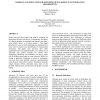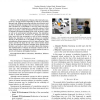50 search results - page 1 / 10 » Modeling and simulation for exploring human-robot team inter... |
FLAIRS
2003
13 years 6 months ago
2003
We have developed a model-based, distributed architecture that integrates diverse components in a system designed for lunar and planetary surface operations: an astronaut’s spac...
WSC
2001
13 years 6 months ago
2001
Small-sized and micro-robots will soon be available for deployment in large-scale forces. Consequently, the ability of a human operator to coordinate and interact with largescale ...
AAAI
2007
13 years 7 months ago
2007
How should a robot represent and reason about spatial information when it needs to collaborate effectively with a human? The form of spatial representation that is useful for robo...
ACHI
2010
IEEE
13 years 11 months ago
2010
IEEE
Abstract—The development of human-robot interaction scenarios is a strongly situation-dependent as well as an extremely dynamic task. Humans interacting with the robot directly r...
HRI
2006
ACM
13 years 10 months ago
2006
ACM
Autonomous robots use sensors to perceive and track objects in the world. Tracking algorithms use object motion models to estimate the position of a moving object. Tracking effic...


